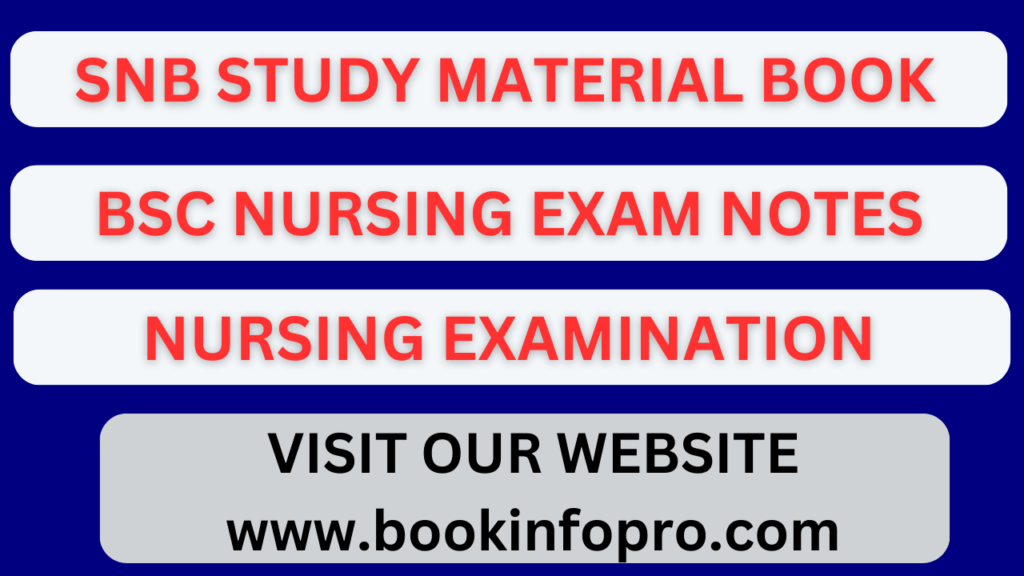Malaysian Nursing Board EXAM (MNB) FREE SAMPLE QUESTION
Malaysian Nursing Board Examination (MNB) Model and Practice Questions
SNB EXAMINATION PRACTICE BOOK VOLUME 1 AND 2 COMBINED AVAILABLE CLICK HERE
Mrs. Johnson, an 80-year-old woman, has been admitted to the hospital for dehydration. Which intervention should the nurse prioritize?
A. Administering pain medication
B. Monitoring vital signs and fluid balance
C. Arranging for physical therapy
D. Initiating a comprehensive cardiac assessment
Answer: B. Monitoring vital signs and fluid balance
An elderly patient with dementia is exhibiting aggressive behavior. What is the nurse’s initial response?
A. Administer a sedative
B. Use physical restraints
C. Identify potential triggers and address them
D. Ignore the behavior
Answer: C. Identify potential triggers and address them
An elderly client is diagnosed with chronic obstructive pulmonary disease (COPD). What nursing intervention is essential for managing respiratory symptoms?
A. Encourage smoking cessation
B. Administer sedatives to promote relaxation
C. Limit physical activity to conserve energy
D. Administer bronchodilators as needed
Answer: D. Administer bronchodilators as needed
An elderly client is diagnosed with heart failure. What nursing intervention is crucial to monitor for fluid overload?
A. Encourage a high-sodium diet
B. Monitor daily weights and assess for peripheral edema
C. Restrict fluid intake to minimize fluid retention
D. Administer diuretics only as needed for symptoms
Answer: B. Monitor daily weights and assess for peripheral edema
A patient is admitted with a diagnosis of urinary retention. What nursing intervention is the priority?
A. Encourage the patient to limit fluid intake
B. Insert an indwelling urinary catheter
C. Administer laxatives to promote bowel movements
D. Provide a diet high in fiber
Answer: B. Insert an indwelling urinary catheter
A patient is admitted with a fractured hip. What nursing intervention is crucial for preventing complications related to immobility?
A. Limiting range of motion exercises
B. Encouraging frequent ambulation
C. Applying restraints to prevent falls
D. Administering sedatives for pain management
Answer: B. Encouraging frequent ambulation
A postoperative patient is at risk for complications due to immobility. What nursing intervention is crucial for promoting early ambulation in the postoperative period?
A. Implement bed rest to conserve energy
B. Encourage ambulation only when absolutely necessary
C. Administer sedatives to promote rest
D. Initiate progressive ambulation as soon as tolerated
Answer: D. Initiate progressive ambulation as soon as tolerated
A patient is admitted with a confirmed diagnosis of methicillin-resistant Staphylococcus aureus (MRSA) infection. What nursing intervention is crucial for preventing the spread of MRSA to other patients?
A. Cohort the patient with another MRSA-positive patient
B. Place the patient in a private room with contact precautions
C. Allow the patient to move freely within the unit to maintain comfort
D. Use the same set of gloves for all patient interactions
Answer: B. Place the patient in a private room with contact precautions
A patient with chronic obstructive pulmonary disease (COPD) is prescribed bronchodilators. What nursing action is essential for effective administration of bronchodilators?
A. Administer bronchodilators only during severe exacerbations
B. Instruct the patient to take deep breaths after inhaler use
C. Limit fluid intake before bronchodilator administration
D. Administer bronchodilators on an empty stomach
Answer: B. Instruct the patient to take deep breaths after inhaler use
A patient is admitted with symptoms of depression. What nursing intervention is crucial for assessing the patient’s risk of self-harm or suicide?
A. Avoid discussing the topic of suicide to prevent distress
B. Assess the patient’s suicidal ideation, plans, and intent
C. Provide the patient with complete privacy to express feelings
D. Administer sedatives to calm the patient before discussing emotions
Answer: B. Assess the patient’s suicidal ideation, plans, and intent
A patient is experiencing chest pain and shortness of breath. What nursing action is crucial for managing a suspected myocardial infarction (MI)?
A. Administer antipyretics to reduce fever
B. Encourage the patient to engage in vigorous exercise
C. Provide oxygen therapy and notify the healthcare provider immediately
D. Administer sedatives to promote relaxation
Answer: C. Provide oxygen therapy and notify the healthcare provider immediately
A patient with advanced cancer is admitted to the palliative care unit. What nursing intervention is crucial for addressing the patient’s spiritual needs?
A. Encourage the patient to avoid discussions about spirituality
B. Provide opportunities for the patient to discuss spiritual concerns
C. Administer sedatives to promote rest and relaxation
D. Avoid discussing spiritual matters to prevent emotional distress
Answer: B. Provide opportunities for the patient to discuss spiritual concerns
A patient with diabetes reports feeling shaky, weak, and sweaty. What nursing intervention is crucial for managing hypoglycemia in this patient?
A. Encourage the patient to consume a high-sugar snack or beverage
B. Administer insulin to lower blood glucose levels
C. Limit fluid intake to prevent fluid overload
D. Withhold all diabetes medications to avoid further hypoglycemia
Answer: A. Encourage the patient to consume a high-sugar snack or beverage
You are a nurse assigned to care for a patient with a traumatic wound on their lower leg. The wound is a deep laceration with exposed muscle tissue. The patient has a history of diabetes. You need to provide appropriate wound care to promote healing and prevent complications.
What is the first step in wound care for this patient?
a. Apply an antibiotic ointment
b. Clean the wound with sterile saline
c. Cover the wound with a dry dressing
d. Administer oral antibiotics
Answer: b. Clean the wound with sterile saline
You are a nurse working in a medical-surgical unit, and you are responsible for providing nutrition care to patients. One of your patients is a 55-year-old female with a recent diagnosis of hypertension and hyperlipidemia. She is also overweight and has a family history of cardiovascular disease. Your goal is to educate the patient on nutrition management to improve her overall health.
Questions: What dietary modification is most crucial for managing hypertension?
a. High sodium intake
b. Low potassium intake
c. Increased saturated fat intake
d. Reduced sodium intake
Answer: d. Reduced sodium intake
You are a nurse working on a medical-surgical floor. You have a patient who is admitted with dehydration due to vomiting and diarrhea. The patient also has a history of heart failure. Your goal is to assess and manage the patient’s fluid balance effectively.
Questions: The patient’s blood pressure is low, and the heart rate is elevated. What is the nurse’s initial action?
a. Administer intravenous (IV) diuretics
b. Increase oral fluid intake
c. Monitor fluid intake and output
d. Elevate the patient’s legs
Answer: c. Monitor fluid intake and output
You are a nurse in a surgical unit responsible for providing pre-operative care to patients. Your goal is to ensure the well-being and readiness of patients undergoing various surgical procedures.
Questions: A patient scheduled for surgery asks about the purpose of the pre-operative assessment. What is the nurse’s best response?
a. “To determine your eligibility for surgery.”
b. “To identify any potential risks or complications.”
c. “To administer pre-operative medications.”
d. “To schedule the surgery time.”
Answer: b. “To identify any potential risks or complications.”
You are a nurse responsible for providing post-operative care to patients recovering from various surgical procedures. Your goal is to ensure their safety, comfort, and optimal recovery during the post-operative period.
Questions: The patient has just returned to the post-anesthesia care unit (PACU) after surgery. What is the nurse’s priority assessment?
a. Pain level
b. Respiratory status
c. Surgical site dressing
d. Blood pressure
Answer: b. Respiratory status
You are a nurse responsible for administering medications to patients in a healthcare setting. Your role includes ensuring safe and accurate medication administration, monitoring for potential side effects, and providing patient education regarding their medications.
Questions: The physician orders a medication for a patient, and the nurse is unfamiliar with the drug. What is the nurse’s best action?
a. Administer the medication as ordered
b. Ask a colleague for their opinion
c. Consult the pharmacist or physician for information
d. Skip the medication and document the reason
Answer: c. Consult the pharmacist or physician for information
You are a nurse facing various challenges that require problem-solving skills in a healthcare setting. Your role involves addressing issues related to patient care, collaborating with the healthcare team, and ensuring the well-being of patients.
Questions: A patient is experiencing difficulty communicating their needs due to a language barrier. What is the nurse’s best approach to address this issue?
a. Use a family member as an interpreter
b. Rely on non-verbal communication
c. Utilize a professional medical interpreter
d. Skip communication until the language barrier is resolved
Answer: c. Utilize a professional medical interpreter
As a nurse with a strong foundation in anatomy and physiology, you encounter various clinical situations that require an understanding of the body’s structure and function. Your role involves applying anatomical and physiological knowledge to assess, plan, and provide care to patients.
Questions: A patient is admitted with chest pain, and the healthcare provider suspects a myocardial infarction. Which part of the heart is primarily affected during a myocardial infarction?
a. Right atrium
b. Left atrium
c. Right ventricle
d. Left ventricle
Answer: d. Left ventricle
As a nurse with a background in microbiology, you play a crucial role in preventing, controlling, and managing infections within the healthcare setting. Your knowledge of microbiology is essential for understanding the principles of infection control, antibiotic therapy, and patient care.
Questions: A patient is admitted with a suspected bacterial infection. The healthcare provider orders a Gram stain. What information does a Gram stain provide about bacteria?
a. Size of the bacteria
b. Shape of the bacteria
c. Presence of a cell wall and its characteristics
d. Ability of the bacteria to produce spores
Answer: c. Presence of a cell wall and its characteristics
As a nurse with a solid foundation in the fundamentals of nursing, you are equipped to provide comprehensive and compassionate care to patients. Your knowledge encompasses various aspects, including basic nursing principles, patient assessment, vital signs monitoring, and fundamental nursing procedures.
Questions: A patient has a surgical wound with a dressing. What is the primary purpose of the dressing on a surgical wound?
a. Provide warmth to the wound
b. Prevent infection and promote healing
c. Enhance the appearance of the wound
d. Minimize pain and discomfort
Answer: b. Prevent infection and promote healing
As a pediatric nurse, you play a crucial role in providing care to infants, children, and adolescents. Your expertise encompasses a wide range of pediatric health issues, including growth and development, common illnesses, and family-centered care.
Questions: A 3-month-old infant is brought to the clinic for a well-child visit. What is a developmental milestone expected at this age?
a. Rolling over
b. Crawling
c. Sitting unsupported
d. Responding to their name
Answer: d. Responding to their name
Question: In glycolysis, glucose is converted to pyruvate. What is the net gain of ATP molecules in glycolysis?
a. 1 ATP
b. 2 ATP
c. 4 ATP
d. 8 ATP
Answer: b. 2 ATP
SNB EXAMINATION PRACTICE BOOK VOLUME 1 AND 2 COMBINED AVAILABLE CLICK HERE


Good i want join with mnb
Thanks . You can subscribe and read online
Malashia nursing borders exam free question
Thanks.. we have MALAYSIA PRACTICE BOOK TOO.. you can subscribe and enjoy reading
Can i get more question about MNB EXAM
We do have Malaysia nursing board practice book .. you can subscribe that .. thanks
Where can I sit the MNB exam in Bangladesh and how much does it cost?
I need malaysia nursing board practice book
Thanks.. we have MALAYSIA PRACTICE BOOK TOO.. you can subscribe and enjoy reading
hi sister how is exam it is easy any suggestions for me i am also planning to write MNB Exam
Where can I sit the MNB exam in Bangladesh and how much does it cost?
I need malasiya nursing exam and very useful
hi please share me any MNB model paper! please